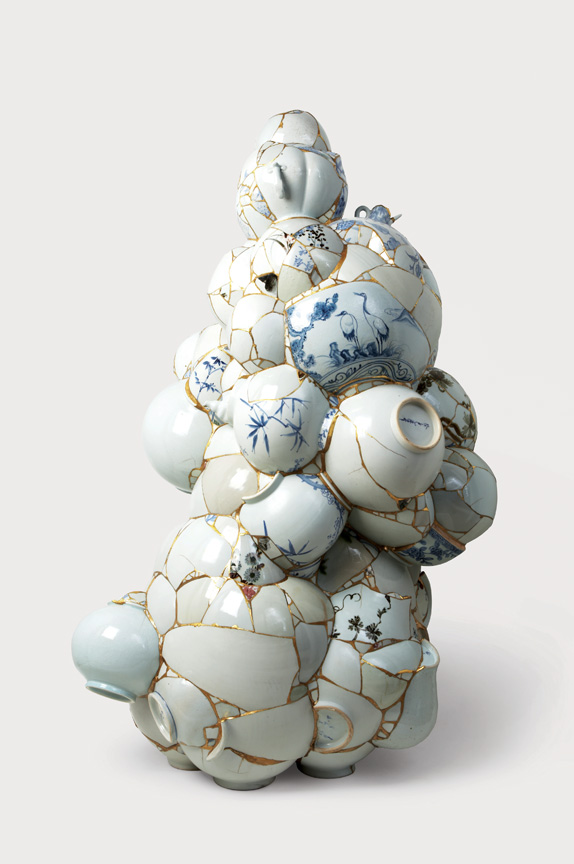Shows
“Weight of History” at Singapore Art Museum


It’s difficult to imagine a private collector buying something like Thai artist Montien Boonma’s Nature's Breath: Arokhayasala (1995). The installation is comprised of modular, makeshift columns formed from metal mesh boxes, the pillars arching at their summits to support numerous bags filled with medicinal plants. It seems incongruous, but eventually one figures out that the sharp, bitter fragrance of dried herbs drifting through the gallery emanates from the cryptic assemblage of industrial objects.
Yet Boonma’s deliberately self-contradictory work—caught in a tension between the physical presence of sculpture and the fleeting ghostliness of scent—is striking, making it one of the highlights of the third annual Collectors Show at the Singapore Art Museum. In a turnaround from the conceptual thinness of the previous year’s show, the present edition, titled “Weight of History,” attempts to demonstrate that private collecting and contextual complexity are not necessarily incompatible; individual art collections may yet prove fertile ground for weighty subject matter.

Similarly, Singaporean Tang Da Wu’s Same Same and No Difference Between Unity and Self-Destruction (1994–2010) hardly looks as if it belongs in a living room somewhere. A pile of hammers held together by nails, the work has been said to simultaneously offer an abstract portrait of former Prime Minister Lee Kuan Yew, and to constitute a vision of a tenuous body politic, brought about by the sheer force of Lee’s personality. Here, however, the piece seems to allude not just to historical narratives, but current political realities: the hammer is the symbol of the opposition Workers’ Party, which, since the game-changing General Elections of 2011, has gone on to capture an unprecedented number of seats in parliament. Obliquely, cannily, the inclusion of Same Same suggests shifts in the political landscape of the so-called nanny state of Southeast Asia, conflating past and the present, authoritarianism and a burgeoning pluralism.
The pressures of tradition are foregrounded in Gonkar Gyatso’s Excuse Me While I Kiss the Sky (2011). A Buddha statue sits on a pedestal in a gold-and-cream-colored gallery, the soft effulgence of the lights overhead veiling the space in a shimmery glow; the scene evokes the candlelit and gold-leafed icons found in Buddhist shrines. Gyatso, however, has plastered the surface of the sculpture and the surrounding walls in children’s stickers, a parade of bright colors and stereotypical, anodyne imagery. The incongruity between sacred idol and mass-produced kitsch is instructive: the figure assumes the bhumisparsha mudra, or gesture of touching the earth, which symbolizes the attainment of enlightenment. The spiritual awakening of the Buddha, in this case, is rendered ironic, mutated into a statement about the incursions of popular culture and globalization into Tibetan socio-religious traditions.
It is Yee Sookyung’s Translated Vase (2007) that provides the ultimate moment of self-reflexive skepticism. The artist has combined pieces and fragments of ceramic ware—those collectible objects par excellence—into a grotesque new form, the result resembling something out of sci-fi or anime. (Think the final scene of Akira.) Here, then, is the culture of collecting turned on its head: the bloated, bulbous amalgamation of cast-off ceramic bits, of broken, fractured remainders, serves to caricature the aura and the authenticity of antiques so fetishized by their admirers. In utilizing a material closely associated with the history of art and of collecting in East Asia, Yee articulates instead a wry, satirical view of the acquisitive practices that so often underlie the determination of art historical canons. Here are no picturesque landscape paintings or conspicuously aesthetic objects, no uncritical celebration of individual taste; what we are presented with, instead, are the broad, socially-oriented engagements that may—and do—inform private visions.
Louis Ho is a freelance art historian and art critic. He is the co-editor of an upcoming journal of Southeast Asian art history, Remote, and works with Grey Projects, an artist-run space in Singapore.







